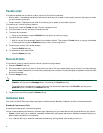
9
2 Operating Your Phone
This section describes how to operate your Cisco Unified IP phone. Because there are differences in phone and site configuration,
not all features and procedures described here may apply to your phone. Consult your system administrator for more
information. This section includes:
• Basic: Place a Call, page 9
• Speakerphone: Place a Call, page 10
• Headset: Place a Call, page 10
• Answer a Call, page 10
• End a Call, page 10
• Redial a Number, page 10
• Hold a Call, page 10
• Mute a Call, page 11
• Manage Call Waiting, page 11
• Retrieve Voice-Mail Messages, page 11
• Call-Blocking (Toll Bar) Override, page 11
• Transfer a Call, page 12
• Forward All Calls, page 12
• Conference Calls, page 12
• Place a Call from Your Local Directory, page 13
• Program Personal Speed-Dial Buttons, page 14
• Place a Call from Your System Speed-Dial Directory, page 14
• View Call History, page 14
• Place a Call from Call History, page 15
• Clear Call History, page 15
• Use Audio Paging, page 15
• Use the Intercom Feature, page 15
• Activate Do Not Disturb, page 16
Note In the following procedures, you may be required to enter information using the keypad. Press the backspace (<<) soft
key to erase digits that were entered incorrectly.
Basic: Place a Call
To place a call, use one of the following methods:
• Lift the handset and dial the number.
• Dial the number and then lift the handset.
• Press the line button for your extension, dial the number, and then lift the handset.
• Press any available button, dial the number, and then lift the handset.
• Press the New Call soft key, dial the number, and then lift the handset.
• Press a speed-dial button and then lift the handset.
• If you have selected a number from a directory, press the Dial soft key, and then lift the handset.


















